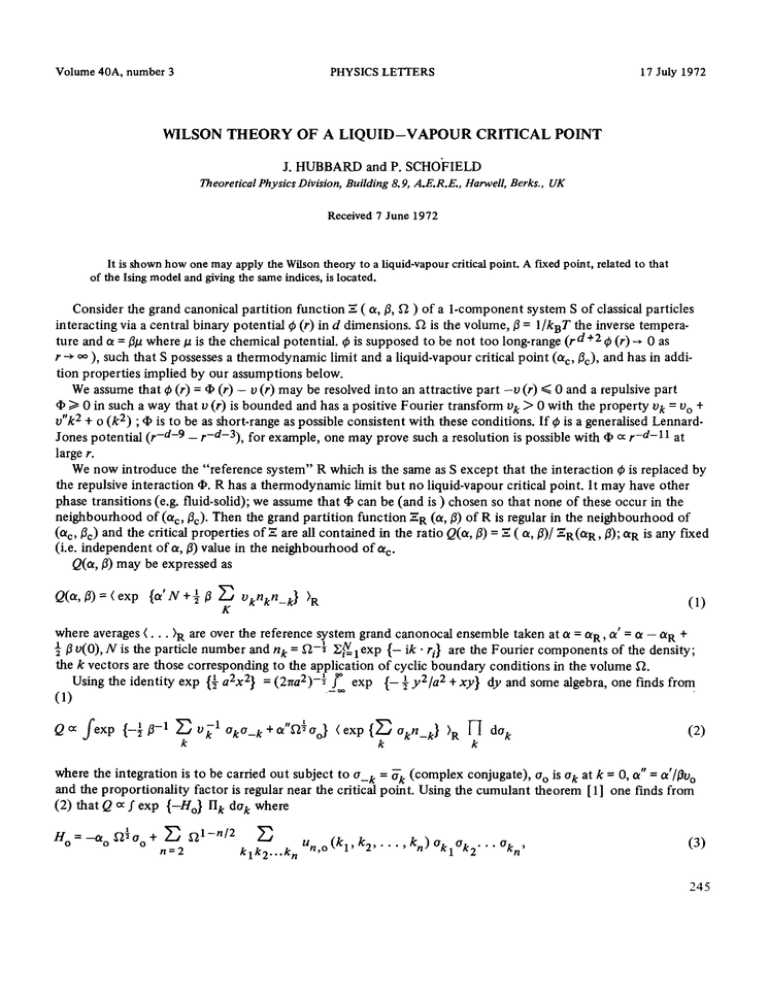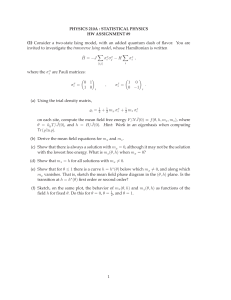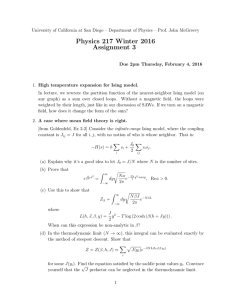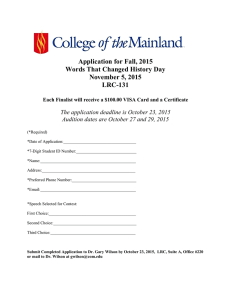Volume 40A, number 3 PHYSICS LETTERS 17 July 1972
advertisement

Volume 40A, number 3
PHYSICS LETTERS
WILSON THEORY OF A LIQUID-VAPOUR
17 July 1972
CRITICAL POINT
J. HUBBARD and P. SCHOFIELD
Theoretical Physics Division, Building 8. 9, A.E.R.E., Harwell, Berks., UK
Received
7 June
1972
It is shown how one may apply the Wilson theory to a liquid-vapour critical point. A fixed point, related to that
of the Ising model and giving the same indices, is located.
Consider the grand canonical partition function ,~ ( tx, 3, ~2 ) of a 1.component system S of classical particles
interacting via a central binary potential ~ (r) in d dimensions, f2 is the volume, 3 = 1/kBT the inverse temperature and o~= 3g where/~ is the chemical potential. ¢ is supposed to be not too long-range (r d +2 ~ (r) ~ 0 as
r ~ oo ), such that S possesses a thermodynamic limit and a liquid-vapour critical point (a c, tic), and has in addition properties implied by our assumptions below.
We assume that ~ (r) = cI, (r) - v (r) may be resolved into an attractive part - o (r) ~< 0 and a repulsive part
i> 0 in such a way that v (r) is bounded and has a positive Fourier transform ok > 0 with the property v k = o o +
o"k 2 + o (k 2) ; • is to be as short-range as possible consistent with these conditions. If ~ is a generalised LennardJones potential (r - d - 9 - r-d-3), for example, one may prove such a resolution is possible with ~ ~ r - d - l l at
large r.
We now introduce the "reference system" R which is the same as S except that the interaction ¢ is replaced by
the repulsive interaction O. R has a thermodynamic limit but no liquid-vapour critical point. It may have other
phase transitions (e.g. fluid-solid); we assume that cI, can be (and is ) chosen so that none of these occur in the
neighbourhood of (ac, tic). Then the grand partition function -~R (a, 3) of R is regular in the neighbourhood of
(ac, 3e) and the critical properties of E are all contained in the ratio Q(ct, d) = .E ( a, 3)/~R(OtR,/3); OtR is any fixed
(i.e. independent of a, d) value in the neighbouthood o f a e.
Q(a,/3) may be expressed as
Q(ot, 3) = (exp { ~ ' N + ½ 13 ~ Vknkn_k } )R
K
(1)
where averages ( . . . ) R are over the reference system grand canonocal ensemble taken at a = O t R , 0 t ' = t~ - - ot R +
½ 3 O(0), N is the particle number and n k = ~2-½ NiN=Iexp { - ik. ri} are the Fourier components of the density;
the k vectors are those corresponding to the application of cyclic boundary conditions in the volume I2.
2 _~_
Using the identity exp {½ a2x 2} = (2~ra)
:2,0 exp { - ½ y2/a2 + xy} dy and some algebra, one Finds from
(1)
Q o:
fexp {-½ fl-1
"-'
~_l o k l OkO_ k + o~ a , Oo} ( exp { ~
k
k
o k n _ k } )R
d°k
(2)
where the integration is to be carried out subject to O_k = °k (complex conjugate), o o is o k at k = 0, a" = a'/3o o
and the proportionality factor is regular near the critical point. Using the cumulant theorem [ 1] one finds from
(2) that Q cc f exp {-Ho} II k do k where
H o = - i x o a-~Oo+ ~ ~21-n/2
n =2
k l k 2. ..k n Un,° ( k l ' k2 . . . . .
kn) OklOk2" " " °kn'
(3)
245
Volume 40A, number 3
PHYSICS LETTERS
ao=S"+~2--~ ( n o ) R , U2, ° ( k , k ' ) =l-~6k+ k, {/3-1Okl - - ( n k n _ k )
17 July 1972
cR } , Un, o(k 1 . . . .
, kn)=-
~n/2-1
X
( n k l n k 2 . . . nkn )cR/n! for n ~> 3, where ( . . . ) c R means the cumulant average. Q is thus expressed as the partition function corresponding to a Hamiltonian H o similar to that of Wilson's Ising-like model in a magnetic field
[2, 3] (s o playing the role of the magnetic field); the new feature is the appearance of the odd order terms in
u3, u 5 . . . . The u n have the following properties required for the further development of the theory: (i) u n is
bounded and independent of ~ and s, (ii) u n vanishes unless k I + k 2 + . . . + k n = 0, (iii) u n has vanishing first
and bounded second derivatives with respect to the k i at 0 = k I = k 2 = . . . = kn, (iv) u 2 (k, - k) > 0 if k > K for
some K. The only appearance of a is through s o which depends linearly upon s.
Starting with H o one may now generate a sequence of Hamiltonians Ill, similar to H o but with s o, Un,o replaced
by a l, Unl , by the procedure described in [2]. As a first step one integrates out all crk with k > K and rescales k-->k/K.
Thereafter at each iteration one integrates out the o k with 1 > k > b-1 and rescales according to k-+bk, ~2-+bd~2,
Olk ~ b 1-~/2ol+l,bk. S l + l , Un, l+1 are then given in terms of s l, Un, l by certain recurrence relations like those of Ising
model case. The new feature is the occurrence of Un, ! for odd n ~> 3. In particular, the presence of the U3, l term prevents one obtaining a stable fixed point. This may be remedied by changing the scaling of Oto (i.e. Olg at k = 0) to Olo~
bl-n/2Ot+l,o +ql, where the ql are chosen in such a way that u3/(0 , 0, 0) vanishes. With this change of scaling one finds
for small enough e = 4 - d and proper choice of r/that a stable f'txed point is given by S l = U2n + 1,l = O, U2n,l = tt~n
where U~n is the Ising model fLxed point located by Wilson and Fisher [2] ; the corresponding value o f q l is zero.
If(s,/3) are suitably chosen i.e. equal to (so,/3c), then the s l, Unl will tend to this fixed point and all the consequences of the Wilson theory [2, 4, 5] for Ising models follow. In particular the indices 7 and ,/will be the same
for the liquid-vapour critical point as for the Ising model. The discussion of the homogeneity relation given in [3]
for Ising models may be suitably generalised and gives
p=po(a,/3)+h
Ihll/a-lm(A
Ih I- r )
(4)
in the neighbourhood of the critical point, where p is the density, P0 a regular function of (s, t3) equal to the crit.
ical density Pc at (s c,/3c), h = s - So, A =/3 --/3c, 8 = (d + 2 - 77) / (d - 2 + ~7), r = (5 - 1) / 76 f rn is essentially the
same function as in the Ising case [3]. The result (4) implies the law of rectilinear diameters. Of course, these resuits only hold for small enough e; their application to the interesting case d = 3, e = 1 is problematic.
We hope to publish a more detailed account of these calculations elsewhere. We should like to thank Drs. J.L.
Beeby and P. Hutchinson for useful discussions.
References
[1]
[2]
[3]
[4]
[5]
246
R. Kubo, J. Phys. Soc. Jap. 17 (1962) 1100.
K.G. Wilson and M.E. Fisher, Phys. Rev. Lett. 28 (1972) 240.
J. Hubbard, Scaling relations in the Wilson theory, Phys. Letters, to be published.
K.G. Wilson, Phys. Rev. B4 (1971) 3184.
K.G. Wilson, Phys. Rev. Lett. 28 (1972) 548.




